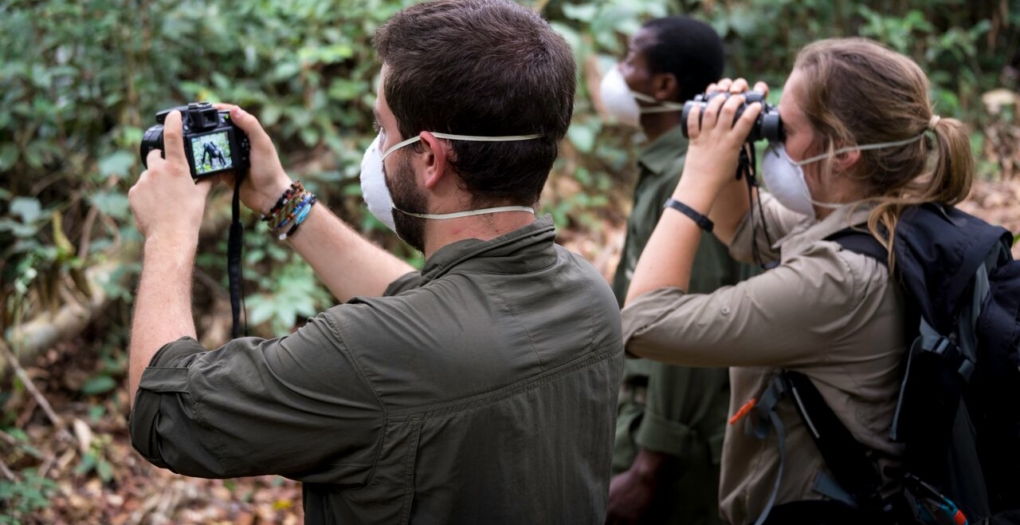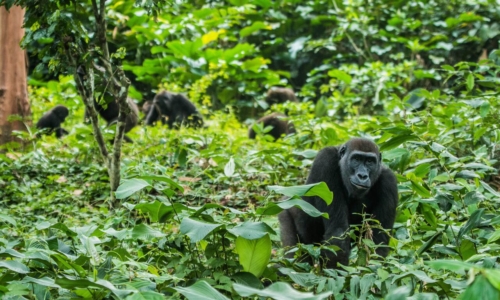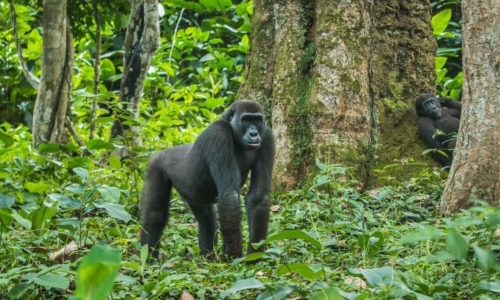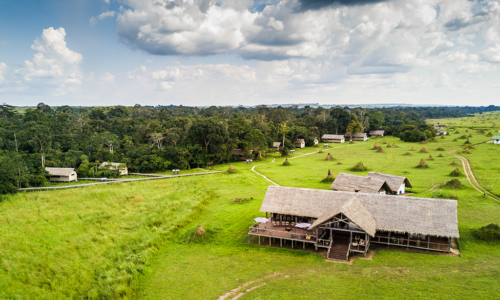The western lowland gorillas favor the lush rainforests of Odzala-Kokoua National Park. One of Africa’s oldest parks, it was established by the French administration in 1935. The park covers some 8,450 miles of pristine rainforest. On average, the forest receives fifty-nine inches of rain per year during its two wet seasons from March-May and September-October. These abundant rains create the beautiful forest, rivers, and marshes within the park.
The western lowland gorillas have several key differences that set them apart from their mountain cousins found in Rwanda and Uganda. For one, they favor the tropical lowland forest areas. They are also smaller and lack the thick fur because of the warmer climate found at these lower altitudes. More importantly from a viewing stand point, they can be a little harder to track as they prefer to rest under tree during midday. Their favorite food is the marantaceae, a shrubby plant found in thick supply on the forest floor. Therefore, they are easier to track and view in the morning when they are feeding and active.
The Ngaga gorilla tracking experience begins from Odzala’s Ngaga Camp in the early morning. Most treks are conducted on foot but can sometimes include a short drive depending on where the gorillas have been discovered that day. Expert guides and trackers use their skills to get close the two gorilla families that have become habituated to visitors and researchers. The minimum ago for gorilla viewing is fifteen for safety and infection reasons. The gorillas cannot be viewed any closer than fifteen feet away with the usual approach being thirty-two to fifty feet away. Only four guests plus a guide and local tracker can go at a time. All visitors must be healthy with no cold, flu, or respiratory symptoms. These excursions can last anywhere from two to eight hours.
The western lowland gorillas are critically endangered with about 100,000 members left around the world. They are threatened by loss of habitat, the bushmeat trade, and human diseases.
Those embarking on a gorilla tracking expedition should remember to prepare accordingly. Good hiking shoes that can traverse muddy terrain are vital to success. Adventurers should bring rain gear as well as sunscreen, a hat, and insect repellant. Of course, a camera minus the flash is an essential for capturing that once in a lifetime moment of watching these majestic primates in their forest home.



The western lowland gorillas favor the lush rainforests of Odzala-Kokoua National Park. One of Africa’s oldest parks, it was established by the French administration in 1935. The park covers some 8,450 miles of pristine rainforest. On average, the forest receives fifty-nine inches of rain per year during its two wet seasons from March-May and September-October. These abundant rains create the beautiful forest, rivers, and marshes within the park.
The western lowland gorillas have several key differences that set them apart from their mountain cousins found in Rwanda and Uganda. For one, they favor the tropical lowland forest areas. They are also smaller and lack the thick fur because of the warmer climate found at these lower altitudes. More importantly from a viewing stand point, they can be a little harder to track as they prefer to rest under tree during midday. Their favorite food is the marantaceae, a shrubby plant found in thick supply on the forest floor. Therefore, they are easier to track and view in the morning when they are feeding and active.
The Ngaga gorilla tracking experience begins from Odzala’s Ngaga Camp in the early morning. Most treks are conducted on foot but can sometimes include a short drive depending on where the gorillas have been discovered that day. Expert guides and trackers use their skills to get close the two gorilla families that have become habituated to visitors and researchers. The minimum ago for gorilla viewing is fifteen for safety and infection reasons. The gorillas cannot be viewed any closer than fifteen feet away with the usual approach being thirty-two to fifty feet away. Only four guests plus a guide and local tracker can go at a time. All visitors must be healthy with no cold, flu, or respiratory symptoms. These excursions can last anywhere from two to eight hours.
The western lowland gorillas are critically endangered with about 100,000 members left around the world. They are threatened by loss of habitat, the bushmeat trade, and human diseases.
Those embarking on a gorilla tracking expedition should remember to prepare accordingly. Good hiking shoes that can traverse muddy terrain are vital to success. Adventurers should bring rain gear as well as sunscreen, a hat, and insect repellant. Of course, a camera minus the flash is an essential for capturing that once in a lifetime moment of watching these majestic primates in their forest home.







 Safari Camps
Safari Camps Points of Interest
Points of Interest Hotels & Resorts
Hotels & Resorts  Journeys
Journeys

































